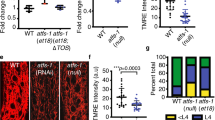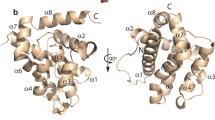Abstract
Genetic analyses in Caenorhabditis elegans have been instrumental in the elucidation of the central cell-death machinery, which is conserved from C. elegans to mammals1,2. One possible difference that has emerged is the role of mitochondria. By releasing cytochrome c, mitochondria are involved in the activation of caspases in mammals3,4. However, there has previously been no evidence that mitochondria are involved in caspase activation in C. elegans. Here we show that mitochondria fragment in cells that normally undergo programmed cell death during C. elegans development. Mitochondrial fragmentation is induced by the BH3-only protein EGL-1 and can be blocked by mutations in the bcl-2-like gene ced-9, indicating that members of the Bcl-2 family might function in the regulation of mitochondrial fragmentation in apoptotic cells. Mitochondrial fragmentation is independent of CED-4/Apaf-1 and CED-3/caspase, indicating that it occurs before or simultaneously with their activation. Furthermore, DRP-1/dynamin-related protein, a key component of the mitochondrial fission machinery, is required and sufficient to induce mitochondrial fragmentation and programmed cell death during C. elegans development. These results assign an important role to mitochondria in the cell-death pathway in C. elegans.
This is a preview of subscription content, access via your institution
Access options
Subscribe to this journal
Receive 51 print issues and online access
$199.00 per year
only $3.90 per issue
Buy this article
- Purchase on Springer Link
- Instant access to full article PDF
Prices may be subject to local taxes which are calculated during checkout




Similar content being viewed by others
References
Horvitz, H. R. Genetic control of programmed cell death in the nematode Caenorhabditis elegans . Cancer Res. 59, 1701s–1706s (1999)
Danial, N. N. & Korsmeyer, S. J. Cell death: critical control points. Cell 116, 205–219 (2004)
Newmeyer, D. D. & Ferguson-Miller, S. Mitochondria: releasing power for life and unleashing the machineries of death. Cell 112, 481–490 (2003)
Jiang, X. & Wang, X. Cytochrome C-mediated apoptosis. Annu. Rev. Biochem. 73, 87–106 (2004)
Sulston, J. E. & Horvitz, H. R. Post-embryonic cell lineages of the nematode, Caenorhabditis elegans . Dev. Biol. 56, 110–156 (1977)
Sulston, J. E., Schierenberg, E., White, J. G. & Thomson, J. N. The embryonic cell lineage of the nematode Caenorhabditis elegans . Dev. Biol. 100, 64–119 (1983)
Chen, F. et al. Translocation of C. elegans CED-4 to nuclear membranes during programmed cell death. Science 287, 1485–1489 (2000)
Conradt, B. & Horvitz, H. R. The TRA-1A sex determination protein of C. elegans regulates sexually dimorphic cell deaths by repressing the egl-1 cell death activator gene. Cell 98, 317–327 (1999)
Bossy-Wetzel, E., Barsoum, M. J., Godzik, A., Schwarzenbacher, R. & Lipton, S. A. Mitochondrial fission in apoptosis, neurodegeneration and aging. Curr. Opin. Cell Biol. 15, 706–716 (2003)
Karbowski, M. & Youle, R. J. Dynamics of mitochondrial morphology in healthy cells and during apoptosis. Cell Death Differ. 10, 870–880 (2003)
Frank, S. et al. The role of dynamin-related protein 1, a mediator of mitochondrial fission, in apoptosis. Dev. Cell 1, 515–525 (2001)
Breckenridge, D. G., Stojanovic, M., Marcellus, R. C. & Shore, G. C. Caspase cleavage product of BAP31 induces mitochondrial fission through endoplasmic reticulum calcium signals, enhancing cytochrome c release to the cytosol. J. Cell Biol. 160, 1115–1127 (2003)
Conradt, B. & Horvitz, H. R. The C. elegans protein EGL-1 is required for programmed cell death and interacts with the Bcl-2-like protein CED-9. Cell 93, 519–529 (1998)
Bloss, T. A., Witze, E. S. & Rothman, J. H. Suppression of CED-3-independent apoptosis by mitochondrial βNAC in Caenorhabditis elegans . Nature 424, 1066–1071 (2003)
van der Bliek, A. M. Functional diversity in the dynamin family. Trends Cell Biol. 9, 96–102 (1999)
Labrousse, A. M., Zappaterra, M. D., Rube, D. A. & van der Bliek, A. M. C. elegans dynamin-related protein DRP-1 controls severing of the mitochondrial outer membrane. Mol. Cell 4, 815–826 (1999)
Shaw, J. M. & Nunnari, J. Mitochondrial dynamics and division in budding yeast. Trends Cell Biol. 12, 178–184 (2002)
Reddien, P. W., Cameron, S. & Horvitz, H. R. Phagocytosis promotes programmed cell death in C. elegans . Nature 412, 198–202 (2001)
Parrish, J., Metters, H., Chen, L. & Xue, D. Demonstration of the in vivo interaction of key cell death regulators by structure-based design of second-site suppressors. Proc. Natl Acad. Sci. USA 97, 11916–11921 (2000)
Hengartner, M. O. & Horvitz, H. R. C. elegans cell survival gene ced-9 encodes a functional homolog of the mammalian proto-oncogene bcl-2. Cell 76, 665–676 (1994)
Hengartner, M. O., Ellis, R. E. & Horvitz, H. R. Caenorhabditis elegans gene ced-9 protects cells from programmed cell death. Nature 356, 494–499 (1992)
Hengartner, M. O. & Horvitz, H. R. Activation of C. elegans cell death protein CED-9 by an amino-acid substitution in a domain conserved in Bcl-2. Nature 369, 318–320 (1994)
Desagher, S. & Martinou, J. C. Mitochondria as the central control point of apoptosis. Trends Cell Biol. 10, 369–377 (2000)
Karbowski, M. et al. Spatial and temporal association of Bax with mitochondrial fission sites, Drp1, and Mfn2 during apoptosis. J. Cell Biol. 159, 931–938 (2002)
Parrish, J. et al. Mitochondrial endonuclease G is important for apoptosis in C. elegans . Nature 412, 90–94 (2001)
Wang, X., Yang, C., Chai, J., Shi, Y. & Xue, D. Mechanisms of AIF-mediated apoptotic DNA degradation in Caenorhabditis elegans . Science 298, 1587–1592 (2002)
Riddle, D. L. & Albert, P. S. in C. elegans II (eds Riddle, D. L., Blumenthal, T., Meyer, B. J. & Priess, J. R.) 739–768 (Cold Spring Harbor Laboratory Press, Cold Spring Harbor, New York, 1997)
Bloom, L. & Horvitz, H. R. The Caenorhabditis elegans gene unc-76 and its human homologs define a new gene family involved in axonal outgrowth and fasciculation. Proc. Natl Acad. Sci. USA 94, 3414–3419 (1997)
Aspock, G., Ruvkun, G. & Burglin, T. R. The Caenorhabditis elegans ems class homeobox gene ceh-2 is required for M3 pharynx motoneuron function. Development 130, 3369–3378 (2003)
Mello, C. & Fire, A. DNA transformation. Methods Cell Biol. 48, 451–482 (1995)
Acknowledgements
We thank E. Lambie, H. Hutter and members of the Conradt laboratory for comments on the manuscript; H. Schnabel and J. Hatzold for discussion; J. Hatzold for generating the integration bcIs51; A. van der Bliek for providing the plasmids myo-3::mitogfp, myo-3::drp-1 and myo-3::drp-1(K40A); S. Hell, S. Jakobs, G. Tavosanis, A. Vollmar and J. Chalcroft for their support with microscopy; and W. Neupert for his support throughout this study. This research was supported by funding from the Deutsche Forschungsgemeinschaft and the Friedrich-Baur-Stiftung to B.W. and by funding from the Max Planck Society, the European Molecular Biology Organization (EMBO Young Investigator Award) and the Howard Hughes Medical Institute (HHMI award to Dartmouth Medical School under the Biomedical Research Support Program for Medical Schools) to B.C.
Author information
Authors and Affiliations
Corresponding author
Ethics declarations
Competing interests
The authors declare that they have no competing financial interests.
Supplementary information
Supplementary Data
Includes Supplementary Tables S1-S4, figure legends for Supplementary Figures S1-S3, and Supplementary references. (DOC 95 kb)
Supplementary Figure 1
Mitochondrial morphology (rhodamine staining) in various cell-death defective mutants. (JPG 66 kb)
Supplementary Figure 2
DIC images of wild-type animals and various cell-death defective mutants treated with icd-1(RNAi). (JPG 60 kb)
Supplementary Figure 3
DIC images of wild-type animals, wild-type animals overexpressing drp-1(wt) or egl-1, and wild-type animals treated with icd-1(RNAi). (JPG 95 kb)
Rights and permissions
About this article
Cite this article
Jagasia, R., Grote, P., Westermann, B. et al. DRP-1-mediated mitochondrial fragmentation during EGL-1-induced cell death in C. elegans. Nature 433, 754–760 (2005). https://doi.org/10.1038/nature03316
Received:
Accepted:
Issue Date:
DOI: https://doi.org/10.1038/nature03316
This article is cited by
-
Mdivi-1 Rescues Memory Decline in Scopolamine-Induced Amnesic Male Mice by Ameliorating Mitochondrial Dynamics and Hippocampal Plasticity
Molecular Neurobiology (2023)
-
Melatonin abated Bisphenol A–induced neurotoxicity via p53/PUMA/Drp-1 signaling
Environmental Science and Pollution Research (2021)
-
Activation of dynamin-related protein 1 - dependent mitochondria fragmentation and suppression of osteosarcoma by cryptotanshinone
Journal of Experimental & Clinical Cancer Research (2019)
-
Mitochondrial Neuroglobin Is Necessary for Protection Induced by Conditioned Medium from Human Adipose-Derived Mesenchymal Stem Cells in Astrocytic Cells Subjected to Scratch and Metabolic Injury
Molecular Neurobiology (2019)
-
Starfish Apaf-1 activates effector caspase-3/9 upon apoptosis of aged eggs
Scientific Reports (2018)
Comments
By submitting a comment you agree to abide by our Terms and Community Guidelines. If you find something abusive or that does not comply with our terms or guidelines please flag it as inappropriate.



